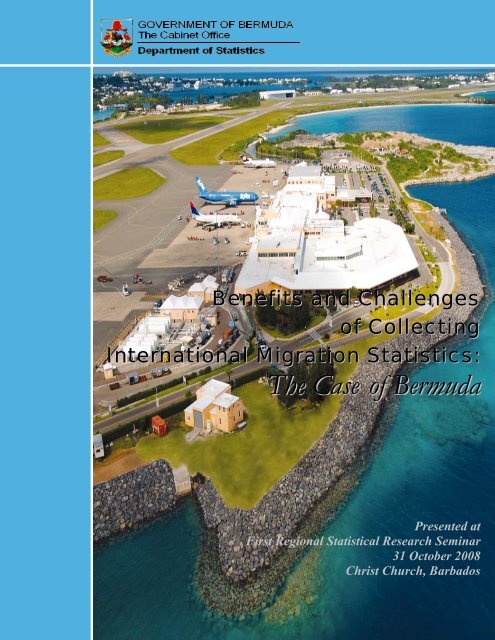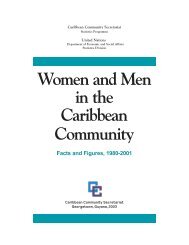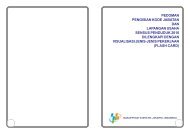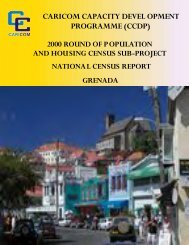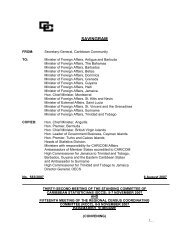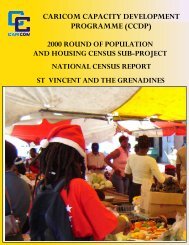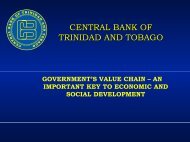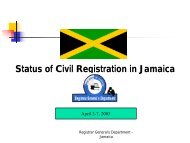The Case of Bermuda - CARICOM Statistics
The Case of Bermuda - CARICOM Statistics
The Case of Bermuda - CARICOM Statistics
You also want an ePaper? Increase the reach of your titles
YUMPU automatically turns print PDFs into web optimized ePapers that Google loves.
Prepared by Melinda WilliamsSocial StatisticianSocial DivisionDepartment <strong>of</strong> <strong>Statistics</strong>9 October 2008ii
iTable <strong>of</strong> ContentsAbstract……………………………………………………………………………………………1Introduction………………………………………………………………………………………..2Definitions…………………………………………………………….…………………………...2Overview <strong>of</strong> <strong>Bermuda</strong>’s International Migration Patterns...………………………………………3<strong>The</strong> Benefits <strong>of</strong> Collecting Migration <strong>Statistics</strong>…………………………………………………...5Migration Rates……………………………………………………………………...…...….5Global Sources <strong>of</strong> International Migration ……...……………………………………………….7Census……………………………………………………………………….…….................7Population Registers…………………………………………………………………………7Border Control…………………………………………………………………….…………8Other Sources………………………………………………………………………………...8Sources <strong>of</strong> International Migration Data in <strong>Bermuda</strong>…………..………………….…...................92003 Adult Literacy and Life Skills (ALLS) Survey ..…………………………........……….9Department <strong>of</strong> Immigration (DOI)..……..………………………………………..…………..9Decennial Census………………………………………………………………....................11Challenges for Measuring International Migration in <strong>Bermuda</strong>………………………................11Alternative Strategies for Measuring International Migration...………………..……..................12UN Recommendations for Data Collection……………………………………..……………….13Recommended Tabulations on the Foreign and Foreign-Born Population……………...……....13Conclusion.……..……………………….………………………………………….....................13Appendix…………………..…………………………………………………………………….15Appendix A1 Core and Optional Information on Incoming International Migrants…………….16Appendix A2 Core and Optional Information on Departing International Migrants...………….24Appendix B………………………………………………………………………………………28References…………..……………………………………………………………………..……..31
iiTableTable 1 Estimated Number <strong>of</strong> Work Permits Issued for Private Sector Employees……….10FigureFigure 1 Historical Origin <strong>of</strong> <strong>Bermuda</strong>’s Chief Peoples…………………..…………..….....3Figure 2 Current Origins <strong>of</strong> <strong>Bermuda</strong>’s People, 2000………………………....……………4Figure 3 Example <strong>of</strong> <strong>Bermuda</strong>’s Passenger Arrival Form…...………………...……..……10
Abstract<strong>The</strong> world is becoming a global village as more persons are migrating than ever before. Despitethe magnitude <strong>of</strong> migration worldwide, it remains the most difficult demographic variable tomeasure. Estimates are therefore used <strong>of</strong>ten to approximate migratory stocks and flows.Resolving this dilemma will have broad implications. This case-study paper defines types <strong>of</strong>migration and provides an overview <strong>of</strong> migration to <strong>Bermuda</strong> as well as the contribution <strong>of</strong>migrants to the Island’s diverse tapestry and their societal impacts. <strong>The</strong> benefits <strong>of</strong> collectingmigration statistics and calculating rates are outlined and the sources <strong>of</strong> international migrationstatistics are discussed. In addition, the paper examines three sources <strong>of</strong> these statistics for<strong>Bermuda</strong> and highlights the challenges <strong>of</strong> collecting the data for the production <strong>of</strong> populationprojections. Alternative strategies and the United Nations’ recommendations for collecting anddisseminating immigration and emigration statistics are also explored, which would reduce thefuture need for estimating these for <strong>Bermuda</strong> and throughout the Caribbean Community. <strong>The</strong>implication <strong>of</strong> adopting some <strong>of</strong> these strategies would be significant movement towardsworking with other jurisdictions to improve migration statistics in the twenty-first century andbeyond.1
2IntroductionAnnually, beginning the 18 th <strong>of</strong> December, 1999 the United Nations (UN) has been recognizingInternational Migrants Day. For the occasion countries are invited “… to observe the daythrough the dissemination <strong>of</strong> information on the human rights and fundamental freedoms <strong>of</strong>migrants, and through the sharing <strong>of</strong> experiences and the design <strong>of</strong> actions to ensure theirprotection.” 1On the 8 th anniversary <strong>of</strong> International Migrants Day in 2007, UN Secretary-General Ban Kimoon’sobservance message stated that this is:…an occasion that grows more meaningful with each passing year. Globalizationand the growing disparities in living conditions within and among States arecombining to increase the scale <strong>of</strong> cross-border migration worldwide. Currently,there are more people living outside their countries <strong>of</strong> birth than ever before, anestimated 200 million in 2007. 2Migration is the act or process <strong>of</strong> people moving from one geographical location to another.<strong>The</strong>re are two types <strong>of</strong> migration – internal migration and international migration. Internalmigration is the movement <strong>of</strong> people within a country, while international migration is thechange from the country <strong>of</strong> usual residence (where a person normally spends the daily period <strong>of</strong>rest), to reside in another. It is important to refine these distinctions between types <strong>of</strong>‘migration’ as the time element plays a crucial role in determining whether persons who travelinternally and internationally are visitors or residents. Migration excludes temporary (less than12 months) travel for visiting, vacation, or business purposes. In an effort to distinguish betweencommuters who cross international borders, the UN developed the concept <strong>of</strong> long-and shorttermmigrant (box below).DefinitionsLongtermmigrantShort-termmigrantA person who moves to a country other than that <strong>of</strong> his or her usual residence for aperiod <strong>of</strong> at least a year (12 months), so that the country <strong>of</strong> destination effectivelybecomes his or her new country <strong>of</strong> usual residence. From the perspective <strong>of</strong> thecountry <strong>of</strong> departure, the person will be a long-term emigrant and from that <strong>of</strong> thecountry <strong>of</strong> arrival, the person will be a long-term immigrant.A person who moves to a country other than that <strong>of</strong> his or her usual residence for aperiod <strong>of</strong> at least 3 months but less than a year (12 months), except in cases where themovement to that country is for purposes <strong>of</strong> recreation, holiday, visits to friends andrelatives, business, medical treatment, or religious pilgrimage. For purposes <strong>of</strong>international migration statistics, the country <strong>of</strong> usual residence <strong>of</strong> short-term migrantsis considered to be the country <strong>of</strong> destination during the period they spend in it. 31 http://www.un.org/depts/dhl/events/migrants/2 http://www.un.org/apps/sg/sgstats.asp?nid=29223http://unstats.un.org/unsd/publication/SeriesM/SeriesM_58rev1E.pdf
3Overview <strong>of</strong> <strong>Bermuda</strong>’s International Migration Patterns<strong>Bermuda</strong>, a British Dependent Territory, is an archipelago <strong>of</strong> 260 mainly uninhabitable smallislands and islets in the Atlantic Ocean located 644 miles south east <strong>of</strong> North Carolina, its closestcontinental destination. <strong>The</strong> population mainly reside on 8 larger islands linked by bridges. <strong>The</strong>seislands are one <strong>of</strong> the few places in the world that did not have a known indigenous population atthe time <strong>of</strong> Spanish discovery. As a result, <strong>Bermuda</strong> has a long history <strong>of</strong> immigration that datesback to 1609 with the arrival <strong>of</strong> the first English settlers. Below, are two maps in succession; oneshows the historical origin <strong>of</strong> <strong>Bermuda</strong>’s chief peoples and the other shows the origins <strong>of</strong><strong>Bermuda</strong>’s people as <strong>of</strong> 2000. Historically, the main sources <strong>of</strong> <strong>Bermuda</strong>’s population were fromAfrica, Europe, the United States <strong>of</strong> America, and the Caribbean (Figure 1).Figure 1. Historical origin <strong>of</strong> <strong>Bermuda</strong>’s chief peoples. 44 Robinson, Kenneth. (1972). Atlas for <strong>Bermuda</strong>. Scotland: Longman Atlases. p. 13.
4Subsequently, the source <strong>of</strong> <strong>Bermuda</strong>’s immigrants expanded to include Canada, the Azores orPortugal, the Philippines, Central and South America, other Asia, and other countries (Figure 2).Figure 2. Current origins <strong>of</strong> <strong>Bermuda</strong>’s peoples, 2000. 5In 2000, 28% (17,675) <strong>of</strong> <strong>Bermuda</strong>’s population was foreign-born, which is higher than in manyOrganization for Economic Cooperation and Development (OECD) countries. 6 <strong>The</strong> majorcountries <strong>of</strong> origin <strong>of</strong> <strong>Bermuda</strong>’s foreign-born population were as follows: United Kingdom(27%), United States <strong>of</strong> America (19%), Canada (14%), Caribbean (12%), and the Azores orPortugal (10%). Together, persons from these countries comprised 83% <strong>of</strong> the foreign-bornpopulation.Over the centuries, the racial diversity <strong>of</strong> <strong>Bermuda</strong>’s immigrants varied, with each populationbringing its knowledge, skills, ideas and culture, which contributed collectively to <strong>Bermuda</strong>’s richtapestry. At the time <strong>of</strong> the 2000 Population and Housing Census, the foreign-born populationcomprised 72% whites and other races, 21% blacks, and 6% Asian.Today, <strong>Bermuda</strong> continues to attract immigrants; most <strong>of</strong> whom are seeking employmentopportunities. According to the Employment Survey Tabulation Set 2007 7 , almost a third <strong>of</strong> theworkforce comprised non-Bermudians, which indicates <strong>Bermuda</strong>’s reliance on imported labour.Four out <strong>of</strong> ten non-Bermudian workers held jobs as pr<strong>of</strong>essionals or technicians, administrators ormanagers or service workers. One-quarter <strong>of</strong> these workers were not Permanent Residents orspouses <strong>of</strong> Bermudians. <strong>The</strong>se demographics present a number <strong>of</strong> challenges to <strong>Bermuda</strong>’s socio-5 Faiella, Graham. (2007). <strong>The</strong> <strong>Bermuda</strong> Atlas. Thailand: Macmillan Publishers Limited. p. 29.6 http://books.google.com/books?id=TZ5rpZqob5sC&pg=PA60&lpg=PA60&dq=Proportion+<strong>of</strong>+migrants+for+OECD+countries&source=web&ots=SrlpuKoQRd&sig=0MMCSvacGAAWO8y5xqrXnOWsMmQ&hl=en&sa=X&oi=book_result&resnum=10&ct=result#PPA50,M17 Department <strong>of</strong> <strong>Statistics</strong> (2008). Employment Survey Tabulation Set 2007. p. 6.
5economic fabric in terms <strong>of</strong> race and ethnic relations, the demand for affordable housing, privateschoolplacements, and traffic congestion.<strong>The</strong> Benefits <strong>of</strong> Collecting Migration <strong>Statistics</strong>Migration determines the growth <strong>of</strong> populations and modifies the size and demographiccharacteristics <strong>of</strong> the countries <strong>of</strong> origin and destination. <strong>The</strong> inflow <strong>of</strong> migrants can have apositive contribution to the population while the outflow <strong>of</strong> migrants can have the reverse effect.Internationally, issues related to migration such as brain drain, brain gain and brain circulation,remittances, transnational communities, asylums, trafficking, and unauthorized movements, havegenerated concerns nationally regarding low fertility, population ageing, unemployment,poverty, human rights, social integration, xenophobia, and national security. <strong>The</strong>se concernshave led to a re-examination <strong>of</strong> migration policies and heighten the importance <strong>of</strong> migrationstatistics.Data on migration is essential to plan and develop policies and programmes. Knowing thedemographic pr<strong>of</strong>ile <strong>of</strong> the population will equip decision makers with the necessary informationto address infrastructure needs, sustainable development, and social integration.Demographically, data on migration can provide the following:• annual stock <strong>of</strong> migrants – the number <strong>of</strong> persons counted as residing or employed in acountry at a particular point in time;• annual flow <strong>of</strong> migrants – the number <strong>of</strong> persons counted as moving or being authorizedto move, to or from a country, to access employment or to settle over a defined period <strong>of</strong>time, usually a 12 month period; and• pr<strong>of</strong>ile <strong>of</strong> migrants – immigrants and emigrants:1. Immigrants – Someone who comes to a country for the purposes <strong>of</strong> permanentresidence:a) country <strong>of</strong> birthb) purpose <strong>of</strong> immigrationc) occupationd) remittance flows2. Emigrants – Someone who leaves one country to settle in another:a) country <strong>of</strong> destinationb) purpose <strong>of</strong> emigrationc) occupationd) remittance flowsMigration Rates<strong>The</strong> availability <strong>of</strong> migration data allows countries to calculate migration rates, which are used toexpress the relative magnitude <strong>of</strong> immigration, emigration, and or net migration. <strong>The</strong>se rates are
6not used much in the study <strong>of</strong> migration as the necessary data is seldom available. According toShyrock & Siegel (2004), “… no particular set <strong>of</strong> rates has yet become standard.” 8Nevertheless, like fertility and mortality, crude rates can be calculated for migration. <strong>The</strong>se ratesrepresent the number <strong>of</strong> immigrants, emigrants, net migrants or gross migrants per 1,000population (box below). Similarly, specific rates can be calculated by age, sex, race, or othercharacteristics <strong>of</strong> migrants.Migration RatesCrude immigration rate = I x 1,000PCrude emigration rate = E x 1,000PI = ImmigrantsE = EmigrantsP = PopulationCrude net migration rate = I - E x 1,000PCrude gross migration rate = I + E x 1,000PGross immigration: <strong>The</strong> movement into a country.Gross emigration: <strong>The</strong> movement out <strong>of</strong> a country.Gross migration: <strong>The</strong> sum <strong>of</strong> immigration and emigration, while net migration is the differencebetween the two.Gross migration = Immigration + EmigrationNet migration = Immigration - EmigrationGross or total out-migration: Represents all people who leave a particular region during agiven time period (usually a year). <strong>The</strong> gross rate <strong>of</strong> out-migration relates these people to thetotal mid-year population in the region and then multiply by 1,000Gross rate <strong>of</strong> out-migration = Total out-migrants x 1,000Total mid-year populationGross rate <strong>of</strong> in-migration: is the ratio <strong>of</strong> all people who moved into the region during a giventime period to the total mid-year population in that regionGross rate <strong>of</strong> in-migration = Total in-migrants x 1,000Total mid-year population8 Jacob Siegel & David Swanson (Eds.). (2004). <strong>The</strong> Methods and Materials <strong>of</strong> Demography. California:Elsevier Academic Press. p. 485.
7Crude net migration rate (CNMR): <strong>The</strong> net number <strong>of</strong> migrants in a year per 1,000 population.CNMR = Total in-migrants - Total out-migration x 1,000Total mid-year populationTotal migration rate: is the volume <strong>of</strong> migrationTotal migration rate = Total in-migrants + Total out-migrants x 1,000Total mid-year populationMigration turnover rate: <strong>The</strong> ratio <strong>of</strong> the total migration rate to the crude net migration rate.Migration turnover rate = Total migration rate x 1,000Crude net migration rateMigration effectiveness = Crude net migration rate x 100Total migration rateMigration ratio = Net number <strong>of</strong> migrants x 1,000Number <strong>of</strong> births – number <strong>of</strong> deathsGlobal Sources <strong>of</strong> International MigrationThroughout the world, countries have difficulty determining the stock and flow <strong>of</strong> migrants, andmigrant rates because few countries have accurate migration. <strong>The</strong> most common sources <strong>of</strong> dataon migration statistics are censuses, population registers, periodic national population surveys,and administrative records.CensusGenerally, censuses collect limited information on the stock and flow <strong>of</strong> immigrants. Censusquestions on nativity, prior residence and year <strong>of</strong> arrival with other demographic variables canprovide a pr<strong>of</strong>ile <strong>of</strong> the socio-economic characteristics <strong>of</strong> the population. Combined with othersources, immigration statistics from the census serve as a basis for estimating net migrationduring intercensal periods. One shortcoming <strong>of</strong> a census is that it does not account for changesbetween censuses.Population RegistersA population register is an administrative record system that requires residents to register theirplace <strong>of</strong> residence. Separately, this register provides limited information but when it is linkedwith other administrative data it can provide a range <strong>of</strong> demographic variables. It can be builtfrom a base inventory <strong>of</strong> the resident population and its characteristics may be updatedcontinuously by data on births, deaths, changes <strong>of</strong> occupations and places <strong>of</strong> residence,adoptions, marriages, and divorces, etc., where available, as in the case <strong>of</strong> some countries. It isevident that a population register can not only provide information on the size and composition
8<strong>of</strong> the population but also on migration flows. Well developed population registers employ asystem <strong>of</strong> unique personal identification numbers for each record and a unified coding system. Insome countries, population registers are completed at a single date, while other countries, such asSingapore, update their records continually.<strong>The</strong> mechanism <strong>of</strong> regularly updating information about the resident population provides currentvital and migration statistics. This information may be used to support policies and decisions, forinstance on budget allocations for education, pensions, and health care.A population register is an uncommon source <strong>of</strong> migration statistics. Mainly western andnorthern European countries (for example, Austria, Belgium, Denmark, Finland, Germany,Norway, and Sweden) have a system <strong>of</strong> continuous registration. This process is mandatory bylaw and requires persons to update the population register. As an incentive to register, benefitsare <strong>of</strong>ten linked to completing the registration process. For instance, if a person fails to register,he or she may lose his/her eligibility for unemployment insurance, child birth benefits, or theright to vote. A few European nations have a fairly accurate account <strong>of</strong> internal and internationalmigration through the use <strong>of</strong> population registers. Challenges may be encountered, however, inencouraging persons who are leaving the country to de-register if there are no immediatebenefits.Countries without population registers sometimes find it difficult to obtain data on migration. Asa result, many <strong>of</strong> these countries have limited or no information on migration and have to rely onestimation techniques.Border ControlBorder control data is the most common source <strong>of</strong> migration statistics. Sometimes this systemdistinguishes between land border control statistics (movement across land) and port controlstatistics (movement into and out <strong>of</strong> a country via the airports and seaports). <strong>The</strong> collection <strong>of</strong>information at land borders is more difficult than at ports because <strong>of</strong> the heavier flows. Many <strong>of</strong>these persons at land borders are not migrants but daily commuters. Furthermore, sometimesdeclaration forms are not used at land borders and hence it is difficult to distinguish betweentravellers.Other SourcesA register <strong>of</strong> foreign nationals can also provide valuable migration information. It is identical tothe population register, except that it captures information on foreign nationals only.Other sources <strong>of</strong> immigration data include special surveys, such as the United States’ AnnualCurrent Population Survey. This survey seeks information on person’s nativity, previousresidence, and citizenship. Some countries may also undertake a survey <strong>of</strong> the country’s citizenswho are living abroad or obtain a list <strong>of</strong> citizens who have registered at embassies and orconsulates.Another potential source <strong>of</strong> migration data, albeit limited, is pr<strong>of</strong>essional registers. Manypr<strong>of</strong>essionals are required, by law, to register in order to practice their occupation. Obtaining
9statistics regarding the composition <strong>of</strong> those registered can provide an indication <strong>of</strong> stock andflow <strong>of</strong> migrants for particular occupations.Sources <strong>of</strong> International Migration <strong>Statistics</strong> in <strong>Bermuda</strong>Currently, <strong>Bermuda</strong> has three (3) sources <strong>of</strong> migration statistics which are:1. 2003 Adult Literacy and Life Skills (ALLS) survey2. Department <strong>of</strong> Immigration (DOI)3. decennial census1. Adult Literacy and Life Skills (ALLS) SurveyIn 2003, the Department <strong>of</strong> <strong>Statistics</strong> (DOS) conducted an ALLS survey. This survey gatheredthe following migration characteristics:• born in <strong>Bermuda</strong> or abroad,• year first immigrated – foreign born, and• citizenship by birth – foreign born.<strong>The</strong> country <strong>of</strong> birth was not collected. A subsequent question captured citizenship but the datawas not computerized. <strong>The</strong>refore, further analysis is not possible without extracting the filesfrom the <strong>Bermuda</strong> Archives. Information, however, was collected on the year first immigratedfor the foreign-born population.2. Department <strong>of</strong> Immigration (DOI)<strong>Bermuda</strong> has only one border control card, a passenger arrival form, that air and yacht visitorsare required to complete (Figure 3). Cruise ship passengers who arrive and leave via cruiseships and Bermudians are not required to complete this form. Air passenger arrival forms and allair travellers’ (residents and visitors) passports are scanned upon arrival. Electronic manifestsfrom the airlines are processed by the Border Management System (BMS) which interfaces withthe data warehouse (Client Relationship Management (CRM)). Anything that is processed by theDOI is in the data warehouse.<strong>The</strong> DOI does not use the arrival form for statistical purposes but for business intelligence.Presently, the DOI provides the DOS with annual estimates <strong>of</strong> the number <strong>of</strong> work permitsissued for private sector employees by type <strong>of</strong> work permit (Table 1).Table 1Estimated Number <strong>of</strong> Work Permits Issued for Private Sector Employees, 1997 - 2006Type <strong>of</strong> Work Permit 1 1997 1998 1999 2000 2001 2002 2003 2004 2005 2006Total 8,603 8,668 9,084 9,272 10,686 11,113 11,585 15,652 16,716 17,7063 Months 1,696 1,405 1,672 2,021 3,254 3,748 4,463 6,185 6,851 7,092Up to a Year 2 5,768 5,970 5,983 5,661 5,677 5,361 4,961 4,918 4,816 4,9312 - 5 Years 1,139 1,293 1,429 1,590 1,755 2,004 2,161 4,549 5,049 5,6831<strong>The</strong>se are work permits issued to Non-Bermudians Source: Immigration Departmentnot married to Bermudians.2<strong>The</strong> majority are one-year renewal permits.
10Figure 3. Example <strong>of</strong> <strong>Bermuda</strong>’s passenger arrival form.<strong>The</strong> arrival forms capture a range <strong>of</strong> data and statistical reports can be produced by a separateGovernment Passenger Information System Generation Library, which is managed by theDepartment <strong>of</strong> Information Technology Office. Details <strong>of</strong> the aircraft’s arrival information areobtained from the electronic manifests and the following variables are keyed from the forms:• date <strong>of</strong> birth • purpose <strong>of</strong> stay• sex • zip code or country <strong>of</strong> origin• type <strong>of</strong> accommodation • length <strong>of</strong> stayEventually, information that is not included from BMS will be input manually from the arrivalform.
11Information pertaining to yacht and cruise ship arrivals is collected by Her Majesty Customs<strong>Bermuda</strong>. <strong>The</strong> visitor air and sea arrivals are provided to the Department <strong>of</strong> Tourism formonitoring tourists’ travel.In 2007, the DOI launched its data warehouse. This warehouse is comprised <strong>of</strong> six databaseswhich will be a valuable resource for improving the estimation <strong>of</strong> migrants. This system is morerigorous than the older system because more data is collected. Presently, a number <strong>of</strong> vendors areworking on different aspects <strong>of</strong> the system which should be fully operational with historical databy 2010. <strong>The</strong> first year’s data will be available by March 2009.This system will enable the DOI to fulfill requests on demand, and eventually providedepartments with the capability to generate statistical tables and graphs independently based onpre-approved negotiated access.With the exception <strong>of</strong> race, most <strong>of</strong> the data that is required for measuring migration will beavailable through the data warehouse. Currently, the DOI has no intention <strong>of</strong> adding race to thedepartment’s application forms unless it is directed by Cabinet. <strong>The</strong>re is reluctance to add thisvariable as it may increase the rate <strong>of</strong> incomplete forms and thereby delay the processing <strong>of</strong>applications.4. Decennial Census<strong>Bermuda</strong>’s decennial census provides data on the stock, arrival patterns, and socio-economiccharacteristics <strong>of</strong> international migrants. <strong>The</strong> 2000 Population and Housing Census questionnairecollected information on the following migration variables:• country <strong>of</strong> birth – all persons,• year last came to <strong>Bermuda</strong> – foreign born,• ever lived abroad for 1 year or more continuously – <strong>Bermuda</strong> born, and• year last returned to live – <strong>Bermuda</strong> born.Challenges <strong>of</strong> Collecting International Migration <strong>Statistics</strong> in <strong>Bermuda</strong><strong>The</strong> difficulty <strong>of</strong> collecting migration statistics throughout the world is well documented and<strong>Bermuda</strong> is no exception. Migration flows pose particular challenges to the collection andproduction <strong>of</strong> reliable and comparable statistics. In most countries, there are more difficultiesmeasuring emigration than immigration. This is primarily due to the fact that internationalmigrants are difficult to count in their country <strong>of</strong> origin on account <strong>of</strong> their absence.Each time the population projections are prepared in <strong>Bermuda</strong>, the availability <strong>of</strong> migrationstatistics presents a challenge to Officers at DOS. Since 1991, the Department requiresmigration statistics by age, sex, Bermudian status, and race, in order to produce detailedpopulation projections. Disaggregating the population is important given that <strong>Bermuda</strong>’s subpopulationshave different age structure and demographic (fertility, mortality, and migration)levels and patterns, which could result in significant improvements in the accuracy <strong>of</strong> theprojections.
12In 1991 and 2000, there was a lack <strong>of</strong> reliable migration statistics to provide information on thenet flow <strong>of</strong> migrants. <strong>The</strong> estimated number <strong>of</strong> work permits issued for private sectoremployees, provided by the DOI, were inadequate for the purposes <strong>of</strong> producing populationprojections as the data was not readily available by five-year age group, race, and sex. Inaddition, that data excluded public sector work permit holders. Furthermore, there were nostatistics on Bermudian residents, non-Bermudian spouses <strong>of</strong> Bermudians, and PermanentResident Certificate holders as they are not required to inform any authority if they immigrate oremigrate.<strong>The</strong> DOI’s Bermudian Status Register contains over 40,000 persons. This list is notcomprehensive as persons need to apply to be included in this register. As <strong>of</strong> 23 January 2007,however, the number <strong>of</strong> Bermudians on the register increased significantly due to a change in theUnited States’ policy that requires all travellers to the United States, from <strong>Bermuda</strong>, to travelwith their passports. 9 This policy change has led to Bermudians acquiring passports and havingthem stamped by the DOI to indicate that the holder is either:• registered as a Bermudian,• possesses Bermudian status, or• deemed to possess Bermudian status.This list, however, is limited for estimating the stock and flow <strong>of</strong> Bermudians as it includespersons who may or may not be residing on the Island.Alternative Strategies for Collecting International Migration <strong>Statistics</strong>Due to these data deficiencies, estimation was necessary because migration is one <strong>of</strong> the keydemographic variables for producing population projections. <strong>The</strong> Intercensal Cohort-ComponentMethod was used to estimate international migration in <strong>Bermuda</strong> between the 1991 and 2000censuses. This methodology applies life table survival rates to live births and two censuspopulations to determine the average net migration. One disadvantage <strong>of</strong> this methodology isthat the census provides a snap shot – usually every decade.As a result <strong>of</strong> this challenge, it is recommended that steps be taken to establish an internationalmigration database so that the net flow <strong>of</strong> Bermudians and non-Bermudians, by race, sex, andfive-year age group, can be tracked annually.In the interim, the DOS has the potential to have better migration statistics because the <strong>Statistics</strong>Act 2002, Section 5 (1) states: “A census <strong>of</strong> the population <strong>of</strong> <strong>Bermuda</strong> shall be taken in the year2010 and every fifth year thereafter.” 10 This legislative authority makes it possible for the DOSto collect migration statistics quinquennially which can serve as a cross check against the DOI’sdata warehouse.Another solution to this obstacle is to obtain detailed census tables <strong>of</strong> the <strong>Bermuda</strong>-bornpopulation residing overseas from the major countries <strong>of</strong> Bermudian emigration. Developing a9http://hamilton.usconsulate.gov/released_september_15/06_-_electronic_visa_application_form_evaf.html10 http://www.laws.gov.bm/
13protocol whereby countries can exchange census information on the foreign-born population is amethodology that will enhance the estimation <strong>of</strong> emigration and is endorsed by the UN.This data source, however, has some limitations for <strong>Bermuda</strong> as all <strong>Bermuda</strong>-born persons arenot Bermudians. If countries <strong>of</strong> emigration collect data on country <strong>of</strong> citizenship, however, thiswill assist the DOS in obtaining an indication <strong>of</strong> the number <strong>of</strong> Bermudians residing overseas.Another limitation <strong>of</strong> this source is that some Bermudians may report that they are British(because <strong>Bermuda</strong> is a British Dependent Territory) or some other nationality for persons withmultiple citizenships instead <strong>of</strong> reporting Bermudian. Regardless <strong>of</strong> these shortcomings, accessto this data will provide the DOS with an estimate <strong>of</strong> Bermudians emigrating. As <strong>Bermuda</strong>approaches the 2010 census, negotiations should begin with other statistical agencies to establishprotocols to facilitate this data exchange. Similar exchanges exist already among the OECDcountries through the creation <strong>of</strong> an OECD foreign-born population database. 11In addition, the DOS should explore the feasibility <strong>of</strong> asking questions on emigration in the 2010Round <strong>of</strong> Population and Housing Censuses. Tunisia tested this process in its 2004 PopulationCensus and lessons could be learnt from that country. 12In concluding the discussion on data sources, it is important to emphasize the key role <strong>of</strong>censuses. According to the UN, today censuses provide the most comprehensive source <strong>of</strong> dataon the types <strong>of</strong> population stock for the study <strong>of</strong> migration. In countries that are major receivers<strong>of</strong> migrants, census information provides the basis <strong>of</strong> in-depth analysis <strong>of</strong> the economic andsocial aspects <strong>of</strong> international migration. Furthermore, the coverage <strong>of</strong> a census is an asset forcountries with few immigrants.UN Recommendations for Data Collection<strong>The</strong> UN has produced a list <strong>of</strong> core and optional information for the collection <strong>of</strong> immigrationand emigration statistics. In preparing for the 2010 census, <strong>Bermuda</strong> and the CaribbeanCommunity (<strong>CARICOM</strong>) should extend its migration questions to include the UN core topics asoutlined in Appendix A1 and A2. For ease <strong>of</strong> presentation, the items in this appendix, displayseparately inflows and outflows. <strong>The</strong>re is also mention <strong>of</strong> the availability <strong>of</strong> these data items as itrelates to <strong>Bermuda</strong> and <strong>Bermuda</strong>’s recommended position for the 2010 census.Recommended Tabulations on the Foreign and Foreign-Born Populations<strong>The</strong> recommendations outlined by the UN assume that the socio-economic characteristics arecaptured. <strong>The</strong> UN recommends that all tables include age group which should be distributed byfive-year age groups with an open-ended interval <strong>of</strong> 85 years <strong>of</strong> age and over. <strong>The</strong> use <strong>of</strong> otherage groupings is not advised as it reduces the usefulness <strong>of</strong> the data.To facilitate the use <strong>of</strong> data, countries are encouraged to produce census samples in machinereadable form that allow the comparison <strong>of</strong> foreigners and the foreign born with citizens andnatives, respectively (Appendix B).11 http://www.oecd.org/document/51/0,3343,en_2649_33729_40644339_1_1_1_1,00.html12 http://www.unece.org/stats/documents/ece/ces/ge.10/2006/wp.6.e.ppt
14ConclusionGlobally, migration is the most challenging demographic variable for statistical agencies tomeasure because <strong>of</strong> the transient nature <strong>of</strong> people and the limited and non-existent systems inmany jurisdictions to monitor their movement. Despite the volume and the difficulty <strong>of</strong>measuring long-term migration, it is imperative that countries use direct or indirect methods toassess their impact on other countries’ population characteristics and social dynamics. Equippedwith data, nations will be able to more accurately determine pr<strong>of</strong>iles <strong>of</strong> migrants and their stockand flow and to calculate relevant rates to plan policies and programmes.In the past, <strong>Bermuda</strong> had difficulty collecting statistics on international migrants and had toresort to estimates. <strong>The</strong> development <strong>of</strong> the DOI’s data warehouse, legislative authority toconduct a census every five years, tapping into other countries’ foreign-born populationdatabases, investigating Tunisia’s method <strong>of</strong> collecting emigration statistics, and considering theUN’s recommendations for collecting and disseminating immigration and emigration statistics,makes the future <strong>of</strong> obtaining these statistics less daunting.<strong>The</strong> implications <strong>of</strong> this work are far reaching as some <strong>of</strong> the strategies can be implemented in<strong>CARICOM</strong> to enhance understanding <strong>of</strong> international migration. Through collaboration, theregion can develop a foreign-born population database, similar to the OECD database, whichwould facilitate improving migration statistics in the twenty-first century and beyond.
APPENDIX15
Note: <strong>The</strong> core topics are typed in turquoise and the optional topics are typed in black.APPENDIX A1Core and Optional Information on Incoming International MigrantsReturning CitizensInflowsInternational Migrant ForeignersUN TopicsUN PurposeAll CategoriesWho WorkedAbroadAll CategoriesAllowed to Workin the ReceivingCountryDepartmentCountry <strong>of</strong> citizenship<strong>The</strong> Census and Adult Literacy Life-Skills (ALLS) survey collectedinformation on persons withBermudian status. Multiplecitizenship is not captured.Distinctionbetweencitizens andforeigners isessential to theunderstanding<strong>of</strong> the dynamics<strong>of</strong> internationalmigrationCitizenship data is obtained for allair arrivals when passports arescanned. <strong>The</strong> airlines and cruiseships provide also this informationvia electronic manifests.N/A (NotAvailable)N/A<strong>The</strong> Census gathered information onforeign-born non-Bermudians but isunable to specify citizenship. <strong>The</strong> ALLSsurvey collected information on foreignbornnon-Bermudians but the survey isunable to specify citizenship <strong>of</strong> non-Bermudians because the information wasnot entered into the computer.Citizenship data is obtained for all airarrivals when passports are scanned.<strong>The</strong> airlines and cruise ships provide alsothis information via electronic manifests.Nationality is also keyed as part <strong>of</strong> thework permit log-in system.<strong>The</strong> census collected informationon foreign-born non-Bermudiansbut it is unable to specifycitizenship. <strong>The</strong> ALLS surveyobtained information on foreignbornnon-Bermudians but thesurvey is unable to specifycitizenship <strong>of</strong> non-Bermudiansbecause the information was notentered into the computer.Furthermore, these sources donot give us a count <strong>of</strong> thenumber <strong>of</strong> persons who havepermission to seek employmentwho are not working.Nationality is not alwayscollected and computerised inthe current work permit system.After the data warehouse is fullyoperational the data will becomplete.<strong>Statistics</strong>Immigration<strong>Bermuda</strong>'sRecommendations for2010 CensusHistorically, <strong>Bermuda</strong>'s census captures only data on Bermudians and non-Bermudians residents. Adopt UN position and collect country <strong>of</strong>citizenship for all residents.<strong>Statistics</strong>16
Note: <strong>The</strong> core topics are typed in turquoise and the optional topics are typed in black.Core and Optional Information on Incoming International MigrantsReturning CitizensInflowsInternational Migrant ForeignersUN TopicsUN PurposeAll CategoriesWho WorkedAbroadAll CategoriesAllowed to Workin the ReceivingCountryDepartmentSexCollect sex <strong>of</strong>migrants anddo not collect itfrom othersources, suchas name.Information about sex <strong>of</strong> citizens isavailable in the ALLS survey andCensus databasesSex is obtained for all air arrivalswhen passports are scanned. Thisinformation is provided also viaelectronic manifests from theairlines and cruise ships.N/AN/ACensus and ALLS surveygathered information on sex <strong>of</strong>Information about sex <strong>of</strong> citizens is foreign-born workers. It does notavailable in the ALLS survey and Census give us a count <strong>of</strong> the number <strong>of</strong> <strong>Statistics</strong>databasespersons who have permission toseek employment who are notworking.Sex is obtained for all air arrivals whenpassports are scanned. This informationis provided also via electronic manifestsfrom the airlines and cruise ships.Sex for all work permit holders iscomputerised.Department <strong>of</strong> Immigration hasinformation on the sex <strong>of</strong> non-Bermudian spouses <strong>of</strong>Bermudians if they have aspousal letter.Immigration<strong>Bermuda</strong>'sRecommendations for2010 Census<strong>The</strong> census will continue to collect sex for all residents.<strong>Statistics</strong>Date <strong>of</strong> birthAllowsidentification <strong>of</strong>birth cohortsand facilitatesdata on migrantflows.<strong>The</strong> census and ALLS surveycollected the date <strong>of</strong> birth but onlythe age was entered into thecomputer.Date <strong>of</strong> birth is obtained for all airarrivals when passports arescanned. This information isobtained also via electronicmanifests from the airlines andcruise ships.N/AN/A<strong>The</strong> census and ALLS survey collectedthe date <strong>of</strong> birth but only the age wasentered into the computer.Date <strong>of</strong> birth is obtained for all air arrivalswhen passports are scanned. Thisinformation is collected via electronicmanifests from the airlines and cruiseships.<strong>The</strong> census and ALLS surveycollected the date <strong>of</strong> birth but theage is the only information thatwas computerised. <strong>The</strong>y do not<strong>Statistics</strong>provide a count <strong>of</strong> the number <strong>of</strong>persons who have permission toseek employment who are notworking.Date <strong>of</strong> birth for the majority <strong>of</strong>work permit holders iscomputerised.Immigration<strong>Bermuda</strong>'sRecommendations for2010 Census<strong>The</strong> Census will continue to collect date <strong>of</strong> birth for all residents.<strong>Statistics</strong>17
Note: <strong>The</strong> core topics are typed in turquoise and the optional topics are typed in black.Core and Optional Information on Incoming International MigrantsReturning CitizensInflowsInternational Migrant ForeignersUN TopicsUN PurposeAll CategoriesWho WorkedAbroadAll CategoriesAllowed to Workin the ReceivingCountryDepartmentDate <strong>of</strong> arrivalCrucial torecord date sothat it refers toevents <strong>of</strong> themigrant inflowCensus and ALLS survey collectedonly the year <strong>of</strong> arrival.Date <strong>of</strong> arrival is provided viaelectronic manifests from theairlines and cruise ships.N/AN/ACensus and ALLS survey collected onlythe year <strong>of</strong> arrival.Date <strong>of</strong> arrival is provided via electronicmanifests from the airlines and cruiseships.Census and ALLS surveycollected information on year <strong>of</strong>arrival <strong>of</strong> foreigners. It does notgive us a count <strong>of</strong> the number <strong>of</strong> <strong>Statistics</strong>persons who have permission toseek employment who are notworking.Date <strong>of</strong> arrival is provided viaelectronic manifests from theairlines and cruise ships.Immigration<strong>Bermuda</strong>'sRecommendations for2010 Census<strong>The</strong> Census will continue to collect year <strong>of</strong> arrival.<strong>Statistics</strong>Intended duration<strong>of</strong> stayNecessary toidentify longtermimmigrantsN/AN/ABoarder Management Sysytem capturesthis information when persons areinterviewed upon arrival at the airport.Work permit system is used tocapture duration <strong>of</strong> stay. <strong>The</strong>system is 85% complete becaueit excludes persons who are not Immigrationworking whose paper work isprocessed manually.<strong>Bermuda</strong>'sRecommendations for2010 CensusPrevious country <strong>of</strong>usual residence<strong>Bermuda</strong>'sRecommendations for2010 CensusUseful indeterminingwhere theperson livedduring the yearprior to arrival.A decision has not been made by the Census Planning Team (CPT).N/A N/A Paper files exists. Paper files exists.A decision has not been made by the CPT.<strong>Statistics</strong>Immigration<strong>Statistics</strong>18
Note: <strong>The</strong> core topics are typed in turquoise and the optional topics are typed in black.Core and Optional Information on Incoming International MigrantsReturning CitizensInflowsInternational Migrant ForeignersUN TopicsUN PurposeAll CategoriesWho WorkedAbroadAll CategoriesAllowed to Workin the ReceivingCountryDepartmentCountry <strong>of</strong> birthUseful in Census database collectsidentifying the information on 16 countries andpopulation <strong>of</strong> regionslife-timemigrants and indefining ameasure <strong>of</strong>migrant stockN/AN/AN/ACensus database collects information on16 countries and regionsPaper files and computerization <strong>of</strong> data isunder development.<strong>The</strong> census gathered informationon 16 countries <strong>of</strong> birth. It doesnot give us a count <strong>of</strong> the<strong>Statistics</strong>number <strong>of</strong> persons who havepermission to seek employmentwho are not working.Paper files and computerization<strong>of</strong> data is under development forpersons who are applying for Immigrationwork permits.<strong>Bermuda</strong>'sRecommendations for2010 CensusAdopt UN position and collect specific country <strong>of</strong> birth instead <strong>of</strong> using regions. It is vital to expand the list <strong>of</strong> countries due to the growing diversity<strong>of</strong> <strong>Bermuda</strong>’s foreign-born population. In 2000, 15% <strong>of</strong> the foreign-born population were from regions (e.g. Other Europe, Other Caribbean) upfrom 12% in 1991.<strong>Statistics</strong>Marital statusGathered frommigrants aged15 years orover by nevermarried,married,separated ordivorced andwidowedCensus collected marital status forresidents 15 years and olderN/AN/AN/ACensus collects marital statusinformation on foreign-born persons 15years and olderCensus gathered information onmarital status <strong>of</strong> foreign-bornworkers. It does not give us acount <strong>of</strong> the number <strong>of</strong> personswho have permission to seekemployment who are notworking.Paper files and computerization <strong>of</strong> data is Paper files and computerizationunder development<strong>of</strong> data is under development<strong>Statistics</strong>Immigration<strong>Bermuda</strong>'sRecommendations for2010 Census<strong>The</strong> census will continue to gather marital status for persons 15 years and over by the recommended categories.<strong>Statistics</strong>19
Note: <strong>The</strong> core topics are typed in turquoise and the optional topics are typed in black.Core and Optional Information on Incoming International MigrantsReturning CitizensInflowsInternational Migrant ForeignersUN TopicsUN PurposeAll CategoriesWho WorkedAbroadAll CategoriesAllowed to Workin the ReceivingCountryDepartmentExpected location<strong>of</strong> place <strong>of</strong> usualresidence inreceiving countryUseful in Census collected actual place <strong>of</strong>determining the usual residencegeographicaldistribution <strong>of</strong>internationalmigrants in thereceivingcountryN/AN/AN/ACensus collected actual place <strong>of</strong> usualresidenceDoes not track permanent address onlytracks temporary address.Census collected location <strong>of</strong>usual residence <strong>of</strong> foreign-bornworkers. It does not give us acount <strong>of</strong> the number <strong>of</strong> personswho have permission to seekemployment who are notworking.Does not track permanentaddress only tracks temporaryaddress.<strong>Statistics</strong>Immigration<strong>Bermuda</strong>'sRecommendations for2010 CensusCensus collects place <strong>of</strong> usual residence as at Census Day.<strong>Statistics</strong>Educational attainment(number <strong>of</strong> yearscompleted schooling)Important toascertainhuman capitalCensus and ALLS survey collectedhighest level <strong>of</strong> schooling andacademic attainmentN/ACensus and ALLS survey collectedhighest level <strong>of</strong> schooling and academicattainmentCensus gathered information onthe highest level <strong>of</strong> schoolingand educational attainment <strong>of</strong>foreign-born workers. It does not<strong>Statistics</strong>give us a count <strong>of</strong> the number <strong>of</strong>persons who have permission toseek employment who are notworking.<strong>Bermuda</strong>'sRecommendations for2010 CensusN/A N/A Paper files exists. Paper files exists.A decision has not been made by the CPT.Immigration<strong>Statistics</strong>20
Note: <strong>The</strong> core topics are typed in turquoise and the optional topics are typed in black.Core and Optional Information on Incoming International MigrantsUN TopicsDuration <strong>of</strong> stayin previous country<strong>of</strong> usual residence<strong>Bermuda</strong>'sRecommendations for2010 CensusPurpose <strong>of</strong> stayabroad<strong>Bermuda</strong>'sRecommendations for2010 CensusType <strong>of</strong> visas or permit<strong>Bermuda</strong>'sRecommendations for2010 CensusUN PurposeIdentifieswhetherpersons areshort-term orlong-termmigrantsEstablishesreasons fortravel andidentifies shorttermmigrants.Determines themigrantcategory towhich theforeignerbelongsReturning CitizensAll CategoriesCollected information on <strong>Bermuda</strong>bornpersons who resided overseasfor one year or more.Who WorkedAbroadN/AInflowsInternational Migrant ForeignersAll CategoriesA decision has not been made by the CPT.Allowed to Workin the ReceivingCountryDepartment<strong>Statistics</strong><strong>Statistics</strong>N/A N/A N/AA decision has not been made by the CPT.<strong>Statistics</strong>This data is 100% computerizedPaper files exists and data isfor work permit holders and workcomputerized for work permit dependentsImmigrationpermit dependents.A decision has not been made by the CPT.<strong>Statistics</strong>Duration <strong>of</strong> validity<strong>of</strong> current permit<strong>Bermuda</strong>'sRecommendations for2010 CensusDetermines thelikely length <strong>of</strong>stay <strong>of</strong> aforeigner in thereceiving StateThis data is 100% computerizedPaper files exists and data isfor work permit holders and workcomputerized for work permit dependentsImmigrationpermit dependents.A decision has not been made by the CPT.<strong>Statistics</strong>21
Note: <strong>The</strong> core topics are typed in turquoise and the optional topics are typed in black.Core and Optional Information on Incoming International MigrantsReturning CitizensInflowsInternational Migrant ForeignersUN TopicsUN PurposeAll CategoriesWho WorkedAbroadAll CategoriesAllowed to Workin the ReceivingCountryDepartmentOccupation inprevious country<strong>of</strong> usual residenceAssessesimpact <strong>of</strong>migration oneconomy <strong>of</strong>countryN/AThis data is computerised forpersons who complete theirapplication online.Immigration<strong>Bermuda</strong>'sRecommendations for2010 CensusA decision has not been madeby the CPT.<strong>Statistics</strong>Industry <strong>of</strong> employerin previous country<strong>of</strong> usual residenceAscertainsindustry inwhich theyhave worked orwill workN/AN/AImmigration<strong>Bermuda</strong>'sRecommendations for2010 CensusA decision has not been madeby the CPT.<strong>Statistics</strong>Status in employment inprevious country <strong>of</strong>usual residenceAssessesimpact <strong>of</strong>migration oneconomy <strong>of</strong>countryN/AThis data is computerised forpersons who complete theirapplications online.Immigration<strong>Bermuda</strong>'sRecommendations for2010 CensusA decision has not been madeby the CPT.<strong>Statistics</strong>22
Note: <strong>The</strong> core topics are typed in turquoise and the optional topics are typed in black.Core and Optional Information on Incoming International MigrantsReturning CitizensInflowsInternational Migrant ForeignersUN TopicsUN PurposeAll CategoriesWho WorkedAbroadAll CategoriesAllowed to Workin the ReceivingCountryDepartmentOccupation in receivingcountry<strong>Bermuda</strong>'sRecommendations for2010 CensusAssessesimpact <strong>of</strong>migration oneconomy <strong>of</strong>countryN/AThis is 100% complete and 50%accurate. Department <strong>of</strong>Immigration (DOI) will start usingthe new <strong>Bermuda</strong> Standard <strong>of</strong> ImmigrationOccupation Classification codesin October 2008.<strong>The</strong> census will continue tocollect occupation from main job. <strong>Statistics</strong>Industry <strong>of</strong> employerin receiving countryAscertain theindustry inwhich theyhave worked orwill work bygettinginformationabout futureemployers.N/AThis is 100% complete and 50%accurate. DOI will start using thenew <strong>Bermuda</strong> Economic ActivityImmigrationClassification codes in October2008.<strong>Bermuda</strong>'sRecommendations for2010 Census<strong>The</strong> census will continue tocollect industry for main job.<strong>Statistics</strong>Status in employment inreceiving countryDistinguishesbetween type <strong>of</strong>visa or permitN/AThis is 100% computerised forwork permit holdersImmigration<strong>Bermuda</strong>'sRecommendations for2010 CensusA decision has not been madeby CPT<strong>Statistics</strong>23
Note: <strong>The</strong> core topics are typed in turquoiseand the optional topics are typed in black.APPENDIX A2Core and optional information on departing international migrantsOutflowsItemEmigrating citizensDeparting international migrant foreignersUN RecommendationsAll categoriesIntend to workabroadAll categoriesAllowed toworkin the receivingcountryDepartmentCountry <strong>of</strong> citizenshipNecessary tomeasure theimpact <strong>of</strong>internationalmigration into acountry.Since June 2008, the departure card has beendisbanded and the airlines and cruise shipselectronic manifests have been integrated into theBoarder Management System (BMS) and datawarehouse. In addition, airlines scan passports andthe information gathered (name, date <strong>of</strong> birth, sex,nationality and issuing country for passport) isintegrated into the BMS and data warehouse.N/A (NotAvailable)Since June 2008, the departure card has beendisbanded and the airlines and cruise shipselectronic manifests have been integrated intothe BMS and data warehouse. In addition,airlines scan passports and the informationgathered (name, date <strong>of</strong> birth, sex, nationalityand issuing country for passport) is integratedinto the BMS and data warehouse.N/AImmigration<strong>Bermuda</strong>'sRecommendation for2010 Census<strong>Bermuda</strong> will explore Tunisa's experience capturing emigrating data on its 2004 Populationand Housing Census to determine whether it is feasible to collect this information in<strong>Bermuda</strong>'s 2010 census. Alternatively, <strong>Bermuda</strong> will establish protocols with receivingcountries to receive data about Bermudians and or persons born in <strong>Bermuda</strong> residingabroad.<strong>Statistics</strong>SexAlways collectsex <strong>of</strong> migrantsand do notcollect it fromother sourcessuch as name.Since June 2008, the departure card has beendisbanded and the airlines and cruise shipselectronic manifests have been integrated into theBMS and data warehouse. In addition, airlines scanpassports and the information gathered (name, date<strong>of</strong> birth, sex, nationality and issuing country forpassport) is integrated into the BMS and datawarehouse.N/ASince June 2008, the departure card has beendisbanded and the airlines and cruise shipselectronic manifests have been integrated intothe BMS and data warehouse. In addition,airlines scan passports and the informationgathered (name, date <strong>of</strong> birth, sex, nationalityand issuing country for passport) is integratedinto the BMS and data warehouse.N/AImmigration<strong>Bermuda</strong>'sRecommendation for2010 Census<strong>Bermuda</strong> will continue to collect sex for residents in its census.<strong>Statistics</strong>24
Note: <strong>The</strong> core topics are typed in turquoiseand the optional topics are typed in black.Core and optional information on departing international migrantsOutflowsItemEmigrating citizensDeparting international migrant foreignersUN RecommendationsAll categoriesIntend to workabroadAll categoriesAllowed toworkin the receivingcountryDepartmentDate <strong>of</strong> birthSince June 2008, the departure card has beendisbanded and the airlines and cruise shipsAllows electronic manifests have been integrated into theidentification <strong>of</strong> BMS and data warehouse. In addition, airlines scanbirth cohorts and passports and the information gathered (name, datefacilitates data onmigrant flows.<strong>of</strong> birth, sex, nationality and issuing country forpassport) is integrated into the BMS and datawarehouse.N/ASince June 2008, the departure card has beendisbanded and the airlines and cruise shipselectronic manifests have been integrated intothe BMS and data warehouse. In addition,airlines scan passports and the informationgathered (name, date <strong>of</strong> birth, sex, nationalityand issuing country for passport) is integratedinto the BMS and data warehouse.N/AImmigration<strong>Bermuda</strong>'sRecommendation for2010 Census<strong>Bermuda</strong> will explore Tunisa's experience capturing emigrating data on its 2004 Populationand Housing Census to determine whether it is feasible to collect this information in<strong>Bermuda</strong>'s 2010 census. Alternatively, <strong>Bermuda</strong> will establish protocols with receivingcountries to receive data about Bermudians and or persons born in <strong>Bermuda</strong> residingabroad.<strong>Statistics</strong>Date <strong>of</strong> departureDate <strong>of</strong> arrivaland departureare used tocalculateduration.Since June 2008, the departure card has beendisbanded and the airlines and cruise shipselectronic manifests have been integrated into theBoarder Management and data warehouse. <strong>The</strong>manifests provide information on the date <strong>of</strong>departure.Date <strong>of</strong>departure isavailable formelectronicmanifests butdo not knowpurpose <strong>of</strong> visitDate <strong>of</strong>Since June 2008, the departure card has beendisbanded and the airlines and cruise shipselectronic manifests have been integrated intothe Boarder Management and data warehouse.<strong>The</strong> manifests provide information on the date <strong>of</strong>departure.departure isavailable formelectronic Immigrationmanifests but donot knowpurpose <strong>of</strong> visit<strong>Bermuda</strong>'sRecommendation for2010 Census<strong>Bermuda</strong> will explore Tunisa's experience capturing emigrating data on its 2004 Populationand Housing Census to determine whether it is feasible to collect this information in<strong>Bermuda</strong>'s 2010 census. Alternatively, <strong>Bermuda</strong> will establish protocols with receivingcountries to receive data about Bermudians and or persons born in <strong>Bermuda</strong> residingabroad.<strong>Statistics</strong>25
Note: <strong>The</strong> core topics are typed in turquoiseand the optional topics are typed in black.Core and optional information on departing international migrantsOutflowsItemEmigrating citizensDeparting international migrant foreignersFuture country <strong>of</strong> usualresidence<strong>Bermuda</strong>'sRecommendation for2010 CensusAll categoriesIntend to workabroadAll categoriesAllowed toworkin the receivingcountryDepartmentProvidesinformation onwhere themigrant plans toliveN/A N/A Immigration<strong>Bermuda</strong> will explore Tunisa's experience capturing emigrating data on its 2004 Populationand Housing Census to determine whether it is feasible to collect this information in<strong>Bermuda</strong>'s 2010 census. Alternatively, <strong>Bermuda</strong> will establish protocols with receivingN/A<strong>Statistics</strong>countries to receive data about Bermudians and or persons born in <strong>Bermuda</strong> residingabroad.UN RecommendationsHelpful indetermining lifetimemigrantsCountry <strong>of</strong> birth 1 and to measuremigrant stockN/A N/A N/A N/A ImmigrationMarital status 1Gathered from allmigrants aged 15years or overN/A N/A N/A N/A ImmigrationLocation<strong>of</strong> place <strong>of</strong> usualresidence incountry <strong>of</strong> departure 1Obtain place <strong>of</strong>usual residenceduring the yearbefore his or herdeparture.N/A N/A N/A N/A ImmigrationEducational Attainment(number <strong>of</strong> yearscompleted schooling) 1Important toascertain humancapitalN/A N/A N/A N/A ImmigrationPurpose <strong>of</strong> stay 1Establishesreasons for traveland identifiesshort-termmigrants.N/A N/A Immigration26
Note: <strong>The</strong> core topics are typed in turquoiseand the optional topics are typed in black.Core and optional information on departing international migrantsOutflowsItemEmigrating citizensDeparting international migrant foreignersUN RecommendationsAll categoriesIntend to workabroadAll categoriesAllowed toworkin the receivingcountryDepartmentType <strong>of</strong> permit 1Duration <strong>of</strong> validity<strong>of</strong> current permit 1Determines themigrant categoryto which theforeigner belongsDetermines thelikely length <strong>of</strong>stay <strong>of</strong> aforeigner in thereceiving StateN/A N/A ImmigrationN/A N/A ImmigrationOccupation inprevious country<strong>of</strong> usual residence 1Providesindications <strong>of</strong>occupationalskillsN/A N/A ImmigrationIndustry <strong>of</strong> employerin previous country<strong>of</strong> usual residence 1Providesinformation onthe industry <strong>of</strong>formeremploymentN/A N/A Immigration1 <strong>Bermuda</strong> will explore Tunisa's methodology to determine what is practical to obtain for person who emigrate.27
28APPENDIX BRecommended Tabulations on the Foreign and Foreign-Born Populations<strong>The</strong> tables with the highest priority, according to the United Nations are typed in bold. 13I. Recommended tabulations using both place <strong>of</strong> birth and citizenship1. Population by sex, age group, country <strong>of</strong> birth and citizenship (citizens by birth,citizens by naturalization, foreigners)2. Population by sex, country <strong>of</strong> birth and country <strong>of</strong> citizenship3. Population by sex, place <strong>of</strong> birth (in country <strong>of</strong> enumeration versus abroad) andcitizenship (citizens by birth, citizens by naturalization, foreigners)II. Recommended tabulations using information on place <strong>of</strong> birth1. Population by sex and country <strong>of</strong> birth2. Population by sex, age group and country <strong>of</strong> birth3. Population by sex, marital status and country <strong>of</strong> birth4. Population by sex, educational attainment and country <strong>of</strong> birth5. Population by sex, age group, marital status and place <strong>of</strong> birth (native versus foreign)6. Population by sex, age group, educational attainment status and place <strong>of</strong> birth (nativeversus foreign)7. Foreign-born population by sex and single year <strong>of</strong> age8. Foreign-born population by sex and state or province <strong>of</strong> usual residence in thecountry9. Foreign-born population by sex, country <strong>of</strong> birth and period <strong>of</strong> arrival10. Foreign-born population by sex, age group and period <strong>of</strong> arrival11. Foreign-born population by sex, age group country <strong>of</strong> birth and period <strong>of</strong> arrival12. Foreign-born population by sex age group and previous country <strong>of</strong> usual residence in thecountry13. Foreign-born population by sex, age group, country <strong>of</strong> birth and ability to speak the<strong>of</strong>ficial language(s) <strong>of</strong> the country <strong>of</strong> usual residence14. Foreign-born population by sex, age group country <strong>of</strong> birth and usual language15. Economically active foreign-born population by sex, age group and occupation16. Economically active foreign-born population by sex, age group and industry17. Economically active foreign-born population by sex, age group and status inemployment18. Economically active foreign-born population by sex, occupation and country <strong>of</strong>birth19. Economically active foreign-born population by sex, industry and country <strong>of</strong> birth20. Economically active foreign-born population by sex, age group and occupation andperiod <strong>of</strong> arrival13 http://unstats.un.org/unsd/publication/SeriesM/SeriesM_58rev1E.pdf
2921. Economically active foreign-born population by sex, industry and period <strong>of</strong> arrival22. Economically active foreign-born population by sex, and status in employment andindustry23. Economically active foreign-born population by sex, employment and occupation24. Economically active foreign-born population by sex, industry and occupation25. Economically active foreign-born population by sex, age group, occupation andeducational attainment26. Economically active foreign-born population by sex, age group, industry and educationalattainmentIII. Recommended tabulations using information on citizenship1. Population by sex, age group, and country <strong>of</strong> citizenship2. Population by sex, age group and country <strong>of</strong> citizenship3. Population by sex, marital status and country <strong>of</strong> citizenship4. Population by sex, educational attainment and country <strong>of</strong> citizenship5. Population by sex, age group and citizenship (citizens <strong>of</strong> birth, citizens by birth,naturalization and foreigners)6. Population by sex, age group, marital status and citizenship (citizens <strong>of</strong> birth,citizens by birth, naturalization and foreigners)7. Population by sex, age group, educational attainment and citizenship (citizens <strong>of</strong> birth,citizens by birth, naturalization and foreigners)8. Foreign population by sex and single year <strong>of</strong> age9. Foreign population by sex and state or province <strong>of</strong> usual residence in the country10. Foreign population by sex, country <strong>of</strong> citizenship and migrant category (type <strong>of</strong>permit)11. Foreign population by sex, country <strong>of</strong> citizenship and period <strong>of</strong> arrival12. Foreign population by sex, age group and period <strong>of</strong> arrival13. Foreign population by sex, age group, country <strong>of</strong> citizenship and period <strong>of</strong> arrival14. Foreign population by sex, age group and previous country <strong>of</strong> usual residence15. Foreign population by sex, age group, country <strong>of</strong> citizenship and ability to speak the<strong>of</strong>ficial language(s) <strong>of</strong> the country <strong>of</strong> usual residence16. Foreign population by sex, age group and country <strong>of</strong> citizenship and usual residence17. Economically active foreign population by sex, age group and occupation18. Economically active foreign population by sex, age group and industry19. Economically active foreign population by sex, age group and status in employment20. Economically active foreign population by sex, occupation and country <strong>of</strong>citizenship21. Economically active foreign population by sex, industry and country <strong>of</strong> citizenship22. Economically active foreign population by sex, occupation and period <strong>of</strong> arrival23. Economically active foreign population by sex, industry and period <strong>of</strong> arrival24. Economically active foreign population by sex, status in employment and industry25. Economically active foreign population by sex, status in employment and occupation26. Economically active foreign population by sex, industry and occupation27. Economically active foreign population by sex, age group, occupation and educationalattainment
28. Economically active foreign population by sex, age group, industry and educationalattainment30
31REFERENCESAzhar, M. Rozy. Assistant Chief Immigration Officer, Interview on 16 March 2007 and 5September 2008 at the Department <strong>of</strong> Immigration.Faiella, Graham. (2007). <strong>The</strong> <strong>Bermuda</strong> Atlas. Thailand: Macmillan Publishers Limited.OECD. (2005). Database on Immigrants and Expatriates. Retrieved 5 April 2008, fromhttp://www.oecd.org/document/51/0,2340,en_2649_33931_34063091_1_1_1_1,00.htmlOECD (2003) Trends in International Migration. Retrieved April 10, 2007. Retrieved from,http://books.google.com/books?id=TZ5rpZqob5sC&pg=PA60&lpg=PA60&dq=Proportion+<strong>of</strong>+migrants+for+OECD+countries&source=web&ots=SrlpuKoQRd&sig=0MMCSvacGAAWO8y5xqrXnOWsMmQ&hl=en&sa=X&oi=book_result&resnum=10&ct=result#PPA50,M1Robinson, Kenneth (ed. advisor). (1972). Atlas for <strong>Bermuda</strong>. Scotland: Longman Atlases.Siegel, J. & Swanson, D. (Eds.). (2004). <strong>The</strong> Methods and Materials <strong>of</strong> Demography.California: Elsevier Academic Press.<strong>Statistics</strong> Act 2002. Retrieved 10 September 2008, from http://www.laws.gov.bm/United Nations. (2006). Measuring Emigration through a Census Emigration Module. RetrievedApril 8, 2007, from http://www.un.org/apps/sg/sgstats.asp?nid=2922International Migrants Day 18 December. Retrieved 26 August 2008, fromhttp://www.un.org/depts/dhl/events/migrants/United Nations. (1998). Recommendations on <strong>Statistics</strong> <strong>of</strong> International Migration Revision.New York: United Nations.United Nations Economic Commission for Europe. (2006). Conference <strong>of</strong> European StatisticiansRecommendations for the 2010 Censuses <strong>of</strong> Population and Housing AdvancedCopy Geneva: United Nations.Visas to the United States. Retrieved April 10, 2007, from http://hamilton.usconsulate.gov/released_september_15/06_- _electronic_visa_application_form_evaf.html
Cabinet OfficeDepartment <strong>of</strong> <strong>Statistics</strong>Picture on the cover is courtesy <strong>of</strong> the Department <strong>of</strong> Tourism


